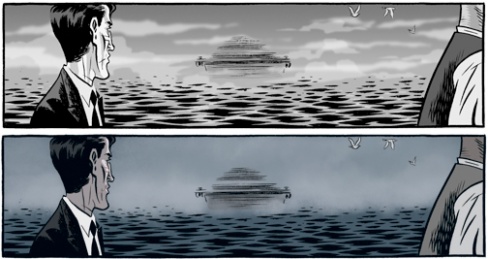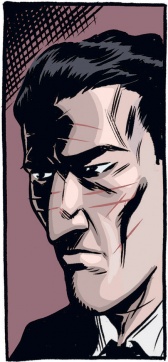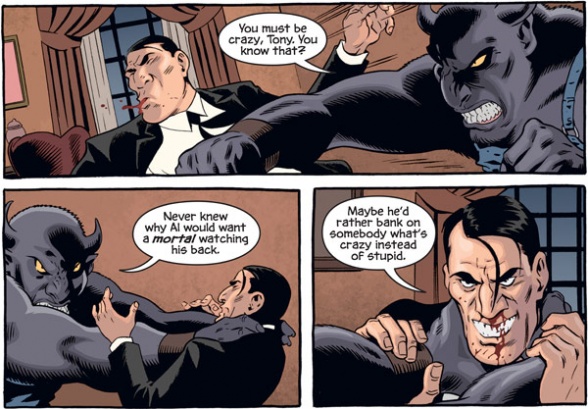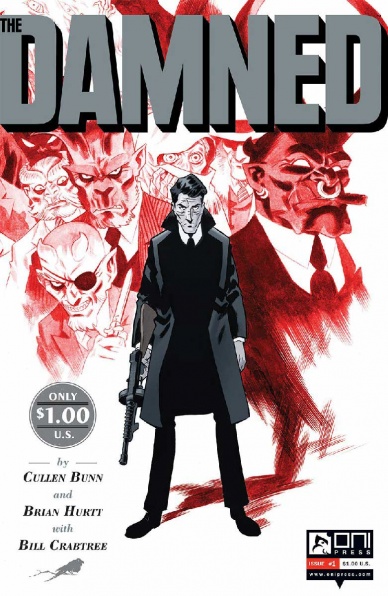
Welcome to The Damned Speakeasy, a column dedicated to “The Damned,” created by Cullen Bunn and Brian Hurtt from Oni Press. This is the first installment, but if you’ve read The Harrow County Observer or Haunted Trails, then you have a pretty good idea what to expect. At the end of each arc, I’ll be talking to the creators and breaking it down, as well as teasing what’s ahead.
This time I’m talking to Cullen Bunn, Brian Hurtt, and colorist Bill Crabtree about “Three Days Dead,” the recently rereleased and newly colored trade collection.

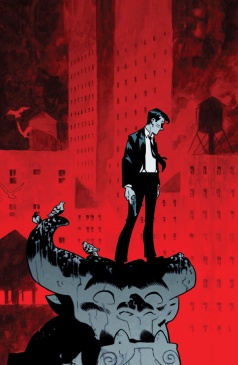
Cullen Bunn: That’s right on both counts! “The Damned” was my first professional sale, kicking off my comic book writing career, so I’m super excited to be returning to it! And we always intended “The Damned” to be a longer series, much like “The Sixth Gun” with a big, epic ending. There’s never been a time when we weren’t talking about this book. We knew we’d come back to it when the stars aligned.
Brian Hurtt: There was never a question that we would go back, it was only a matter of when. The double-edged sword of “The Sixth Gun” success was that we had to wait until we finished telling that story before we could come back to this world.
The series has had about a decade of development time, and both of you have learned so much as storytellers since. So what has it been like revisiting “Three Days Dead” now?
Cullen Bunn: Without sounding too full of myself, I have to say that when I look a “Three Days Dead” I’m still insanely proud of the book. I think it holds up incredibly and ranks among some of my favorite work. There are little things that I notice that I did then that I don’t necessarily do now. Some scenes are longer than I would typically write now. These days, I tend to break up my word balloons and captions a little differently. But this is still very much the kind of story I would sit down and write today.
Brian Hurtt: I have to echo what Cullen said. It may have been his first major comic work but it holds up so well! It’s still up there as one of the best things he’s written. More than once I’ve picked up the book to reference something and I find myself drawn in and reading the whole thing! And I never reread books I drew.
When I look at my older work here, I am struck by how much my storytelling sensibilities have remained the same. There are little things here and there that I might do differently now but overall I am proud of my storytelling work on this book. My draftsmanship though… I see myself in the work but I am much more confident in my drawing and cartooning ability at this time.
The isn’t exactly the same “Three Days Dead” as before though. Most notably, Bill Crabtree has colored the story, which is a huge transformation. You’ve said in other interviews that readers familiar with the original version found that it made the story new for them again.
Cullen: This is 100% a different experience with Bill’s fantastic colors. I’ve said elsewhere that I was a little hesitant when it came to the idea of coloring the book. I thought the tones Brian used originally really played well to the noir feel. But Bill proves me so wrong. His colors bring so much to the story while maintaining the noir esthetic.
Brian: I had multiple people who saw the final product and tell me that it was almost like reading a new book. Bill brings so much to the world and the atmosphere on this book. And it goes without saying that we have a good collaborative relationship and, like Cullen and I, are often on the same page before we even discuss the work.
Continued belowBill Crabtree: I’m glad people seem to like it! Working with Brian and Cullen is a pleasure for me, and I’m happy to continue doing it.
This isn’t just a case of adding color though. The original version of the story used gray tones throughout. Bill, when you were coloring the story, did you look at Brian’s original gray tones or was that something you avoided?
Bill: Yes, I pretty much avoided doing it. There are things Brian did that, looking back, I should have emulated. For me as a colorist, I find that I do better relying on my own instincts. If I look at what someone else has done, it tends to make me second guess myself and everything becomes harder.
Of course, you were also building the color language for the ongoing series. How do you approach a new project like this, which will be running for several years?
Bill: I approach each project on its own terms. I didn’t necessarily think ‘OK, this is a long-running gangsters and demons story, what does that look like?’ Really, I just respond to the art and story on the page. Working with Brian and Cullen, the narrative often suggests color ideas to me and I just try to realize them as fully as I can.
There was something I noticed while reading the story, the way certain scenes tend to become almost like black and white (particularly in panels with striking, typically noir-ish shadows) where a dominant color functions as the gray tone. You can spot practically every scene in this story where Eddie is alone and ruminating, because the colors always become colder, using a narrower range of hues.
Bill: Well, to be honest that’s not something I set out to do intentionally. Maybe it’s as you said, these are scenes where Eddie is alone and brooding. His inner world is conveyed through the colors of the outer one.
I find there are many places in the book where Eddie’s emotional state bleeds into a scene. One of my favorites is a moment near the end, when Eddie’s sadness drains the saturation out of his skin color. It’s not necessarily meant to be taken literally, of course, but I love that when I’m reading, I often feel the effect of this sort of technique without consciously knowing where it’s coming from.
Bill: The way Brian drew that scene suggested the transition to me. As the shot pulls in closer, Eddie’s face betrays more grief. I wanted to amplify that.
I find when I step back and look at a page (or even a sequence) as a whole, there’s a dominant color that identifies the scene. Even with the pages reduced to thumbnails, the colors still tell a story, though one focused more on emotions and intensity.

This approach—giving each scene its own palette—makes for striking scene transitions from one to another. The colors of the approaching sequence seep into the one preceding it. I find this very theatrical.
Bill: I feel that is one of my highest priorities as a colorist. Yes, I try to separate and clarify the elements of each individual panel, but this is equally important with the story as a whole. I try to make each scene distinct and use the various color palettes to evoke emotion and ambiance.
The color wasn’t the only change though. As I understand it, some pages (particularly the ones with the Harvester character) were relettered for the sake of overall consistency with the ongoing series.
Brian: I won’t get into all the technical details but the original letters really weren’t up to snuff. We also just wanted a more unified look to the lettering—a visual continuity. And there was no way I was gonna hand letter all future monster encounters!
Cullen: What we’ve learned here is that ten years ago, Brian was full of youthful craziness and wanted to hand letter all the ‘monster’ dialog. Now, in his old age, time and work/life balance is the ‘monster’ with which he must contend.
Continued belowAnd you’re working with Chris Crank again, your letterer on “The Sixth Gun”. Were the changes with some of the sound effects his suggestion or was that something you asked him to do for this collection?
Brian: Any sound effect changes were my own doing. I always draw my own SFX and back when I was working on this series I was doing those by hand separately. Because of that I was able to go in and redo SFX that I wasn’t particularly happy with or that just needed touching up. Some had to be redone because the layers had been lost from the original file.
Crank is handling all the dialog and narration though and I trust his instincts completely on designing the creature dialog moving forward. We’ve been working with him for years now so there is a solid base of understanding that we all have about each other’s work.
Let’s talk about the story in “Three Days Dead.” I’m going to be frank with you, Eddie’s a real bastard. We’re with him on this story, but he’s not a good guy. Could you tell us how you get readers to engage with and invest in a character like that?
Cullen: Yes, in a world full of demons, there are no real heroes. Eddie is a sonovabitch. He’s a screw up. What’s worse, anyone who enters his orbit tends to get screwed over in some horrible way. I’ve always thought readers engage with Eddie because he spits right in the eye of authority. And—let’s face it—he’s dealing with a pretty corrupt authority. He’s quick-witted and sharp-tongued in a way that we all wish we were. He talks to those demons the way we all want to talk to our boss. It doesn’t hurt that Eddie narrates the story, too, and we’re in his head as he goes on his misadventures.
Eddie’s a real tragic figure, and we’ll be seeing more of that as the ongoing story of “The Damned” continues. We’ll also be adding a few new characters to the mix. Some of them are genuinely good people.
Brian: One of the things that is exciting for me in returning to this work is getting to explore the collateral damage of Eddie’s life. There are numerous people and relationships in his orbit—characters we’ve met and many we haven’t—whose stories are all dark and entwined.
Yeah, even the six-page teaser back in 2006 showed a bit of that collateral damage when Eddie got his demon friend killed.
Cullen: Ah, yes! Little asides like that illustrate that this is a much bigger world and there’s a lot of history there. And yes, Eddie’s screwed a bunch of people over.
Brian: That story was a lot of fun to do. It was the very first “The Damned” car chase scene (but not the last). I believe it was drawn after the first issue was done for promotional purposes. But that bit is absolutely canon and I can’t wait until we get to see it colored as well!
At the end of “Three Days Dead,” Eddie’s really moved up in the world (he started off as a dumped corpse and ended up running the Gehenna Room), but he had to do some pretty dark stuff to get there—in particular, handing Sophie over to the Verlochin.
Cullen: Yeah. That one’s gonna haunt him. That moment leads into a long game that Brian and I have been talking about since that first trade came out.
Brian: I’m giddy with excitement here. Can’t wait until we address that in the ongoing series! Wish we could tell you more!
It’s OK. I like to discover it on the comics page.
Eddie is cursed with resurrection, a curse that some would argue is more of a blessing, especially when we see some of the curses the Verlochin have put on others. Eddie gets to be essentially immortal, but there’s more to it than that. This is no random curse, and the Verlochin clearly have their reasons for cursing Eddie.
Every time Eddie dies, he goes to that strange purgatory world—a place the demons can no longer go—and waiting for him there is the Harvester with his little boxes of souls. Considering the demon families deal in souls, I can’t help but think they’d be very interested in those boxes, and with Eddie’s mother stuck in that purgatory, she may be the leverage the Verlochin need to get them.
Continued belowCullen: Speaking of long games…
Yes, the Verlochin have a twisted plan when it comes to Eddie’s curse. There’s so much more to their grand designs. You have to realize, the Verlochin see themselves as the only true demons in the world, and they’ve been exiled by their ‘lesser’ brethren. They want to get back on top, but there are rules they must follow. Eddie’s is just one piece of a big puzzle to help them attain their goals. And Eddie, as you’ll see, isn’t the only person who plays a role in this grand scheme.
Brian: Mwah-ha-ha! More intrigue! Yes, we have some pretty cool stuff coming down the pike and will be introducing some characters who share a lot of bad, complicated history with Eddie.
“Three Days Dead” was a self-contained story, but even still, there’s clearly a larger story at play. There’s also little threads too, like Tony, apparently a regular human, but capable of holding his own against some nasty demons. Clearly there’s more to him than meets the eye.
And then there’s Sophie, who sold her soul even after seeing how much it had cost Eddie and her brother when they had sold theirs.
Cullen: Yes, we’ve planted a lot of seeds in this first story that play into events in the ongoing tale. Keep your eye on Tony. He’s one of those characters who seems to have a small role, but who ends up being very important. And, like I said, Sophie’s fate will haunt Eddie for a long time to come.
When “The Damned” returns in May as an ongoing series, you’ll be starting a new five-issue story arc, “Ill-Gotten.” How does it feel to be back in this world, writing and drawing it again? How has in changed over the years?
Cullen: It’s exciting and gratifying. We’re finally back to the story that started it all! It’s strange, too, writing these characters after all this time. I’ve been digging through old folders, uncovering notes and plans (like the outline for the never-released “Daughter’s Danse” story) and I’m so pleased that folks will finally have the chance to read the whole tale. We’ve changed a few of the story points, I think, with plans to approach the climax of the series a little differently than we originally planned. But the themes are the same, and most of the ‘milestones’ along the way are still pretty much the way we envisioned them.
Brian: I’m having a blast! It’s so fun to revisit these characters again after so long. It’s kind of like a high school reunion. You see this person (or draw them) for the first time in a while. They look like a stranger to you. Then, the more time you spend talking with (drawing) them they start to come into focus as the person you remember. Then it’s like no time has passed.
It’s also fun to bring everything I’ve learned as an artist over these past ten years to bear on this project. There’s a little bit of a ‘before and after’ to this project. In a way, I feel like I’m competing with my former self and showing him that I can do it even better. Is that weird?
No, I don’t think so. You’re in a strange position where your art has grown in the last ten years, but you’ve still got to fit into the visual continuity you’ve established. Did you find you were tweaking designs to match your current style?
Brian: You’ve hit the nail on the head! That was honestly my biggest concern going into this series and something I struggled with as I was getting my sea legs. If I were launching a brand new series now, my art style would be noticeably different that what I’m doing in “The Damned.” With this story and this world I have to be true to the work I did before. I have to make it as seamless as possible while also doing the best work I can now. There is still a marked difference but it looks and feels more like a cast getting back together for the big screen reunion of their cult show. Everything looks a little prettier but it’s still recognizable as the show you love.
Continued below
“The Damned” ongoing begins May 3 with a $1 first issue. Final order cut off is April 10. You can follow Cullen Bunn on Twitter or check out his website for the most recent news. Brian Hurtt is on Twitter, Tumblr, Instagram, and you can buy his original pages at ComicCon Art. Bill Crabtree is also on Twitter.
In a Prohibition-era world where demonic princes pull the strings that make crime families dance, Eddie is a mortal with two things working for him. First of all, he can’t die. Well, he can and does, quite often, but he doesn’t stay down for long. Second, Eddie runs the Gehenna Room, a nightclub with a strict “no demons allowed” policy. But blessings and curses don’t look all that different these days, and failing to tell the two apart can get a guy killed–over and over again in Eddie’s case. So when one of Eddie’s old pals shows up seeking sanctuary, Eddie knows he’s in for a double-cross, and that means walking the line between salvation and damnation once more.

